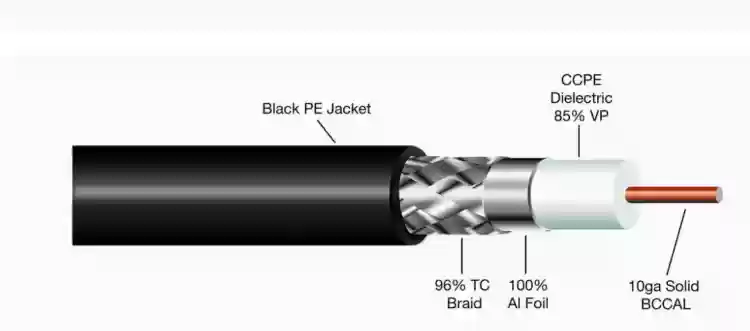HLF cables are high-performance coaxial cables designed to support efficient radio frequency (RF) signal transmission in various communication systems. These cables are essential in applications that require minimal signal loss and robust transmission over long distances. HLF cable offer excellent electrical performance, making them popular in industries like telecommunications, broadcasting, and aerospace. Among the different types, HLF 400 is one of the most widely used variants due to its balance between performance and affordability.
In this article, we will discuss the HLF cable, explore the features of HLF 400 cable, and explain how to choose the right HLF cable manufacturer for your specific needs.
What is an HLF Cable?
An HLF cable is a type of low-loss coaxial cable designed for RF applications. These cables are used to connect RF systems, antennas, and equipment that require minimal signal degradation. The design of HLF cables includes a center conductor, dielectric insulation, shielding, and an outer jacket, all optimized to ensure low attenuation and high-frequency signal transmission.
The performance of HLF cables makes them ideal for a wide range of applications, including mobile communication systems, wireless networks, and satellite communication. Their ability to maintain signal integrity over long distances without significant losses is what sets them apart from standard coaxial cables.
Features of HLF Cables
Low Signal Loss
One of the main advantages of HLF cables is their low signal loss, which makes them ideal for RF applications where maintaining signal strength is critical. These cables are designed to minimize attenuation, ensuring that signals remain strong even over long distances. This feature is especially important in high-frequency applications like 4G, 5G, Wi-Fi, and satellite communication.
High-Frequency Performance
HLF cables are engineered to handle high-frequency signals, making them suitable for modern communication systems. The high-frequency handling capabilities of HLF cables allow them to support a wide range of RF applications, from cellular networks to GPS and Wi-Fi systems.
Durability and Flexibility
Another essential feature of HLF cables is their durability. These cables are constructed to withstand environmental factors such as temperature fluctuations, moisture, and physical wear. The outer jacket of the cable is designed to protect the internal components from environmental damage, ensuring long-term reliability in both indoor and outdoor installations.
In addition to durability, HLF cables offer flexibility, making them easy to install in complex environments. Whether the installation requires the cable to bend around corners or fit into tight spaces, the flexibility of HLF cables simplifies the process.
HLF 400 Cable: A Versatile Solution
Among the various types of HLF cables, HLF 400 cable is one of the most commonly used due to its balance between performance and cost-effectiveness. HLF 400 offers a low-loss solution that is suitable for a wide range of RF applications, from wireless networks to radio communication systems.
Key Specifications of HLF 400 Cable
- Impedance: HLF 400 cable typically has an impedance of 50 ohms, which is the standard for most RF applications. This impedance ensures efficient transmission of RF signals and minimizes reflections and signal degradation.
- Frequency Range: HLF 400 can handle frequencies up to 6 GHz, making it suitable for high-frequency applications like 5G, LTE, and Wi-Fi networks.
- Attenuation: The low attenuation of HLF 400 cable is one of its key features. It ensures that signals remain strong even over long distances, making it ideal for applications where maintaining signal integrity is crucial.
- Durability: Like other HLF cables, HLF 400 is designed to withstand harsh environmental conditions. Its outer jacket protects it from moisture, UV rays, and physical damage, ensuring long-term reliability.
Applications of HLF 400 Cable
HLF 400 cable is used in a variety of applications, including:
- Cellular Networks: HLF 400 is commonly used to connect antennas to base station equipment in cellular towers. Its low attenuation ensures that signals remain strong, even in long-distance installations.
- Wi-Fi Networks: In Wi-Fi and wireless networks, HLF 400 cables are used to connect access points, routers, and antennas, ensuring efficient data transmission and reliable connectivity.
- Satellite Communication: The high-frequency performance of HLF 400 makes it ideal for satellite communication systems, where maintaining signal strength and minimizing loss is critical.
Choosing the Right HLF Cable Manufacturer
Selecting the right HLF cable manufacturer is essential for ensuring the quality and performance of your RF system. A reliable manufacturer will provide high-quality cables that meet your specific needs, whether for indoor or outdoor installations, high-power systems, or sensitive applications.
Factors to Consider When Choosing an HLF Cable Manufacturer
- Quality Control: A reputable HLF cable manufacturer should have stringent quality control processes in place to ensure that each cable meets industry standards. This is especially important in RF systems, where even minor defects can result in significant performance issues.
- Experience and Expertise: Choose a manufacturer with extensive experience in producing RF cables, particularly HLF cables. An experienced manufacturer will have a deep understanding of the challenges involved in RF signal transmission and can offer cables that deliver reliable performance.
- Customization Options: Some manufacturers offer customization options to meet specific requirements. This can include different lengths, connectors, or additional features such as waterproofing or increased durability for outdoor installations.
- Customer Support: Strong customer support is essential when choosing an HLF cable manufacturer. Look for a manufacturer that provides technical support, helping you choose the right cable for your application and assisting with installation or troubleshooting if necessary.
- Compliance with Industry Standards: Ensure that the manufacturer complies with industry standards and certifications, such as ISO or RoHS. This guarantees that the HLF cables they produce are safe, reliable, and meet the necessary performance benchmarks.
Benefits of Using HLF Cables
Improved Signal Quality
One of the primary benefits of using HLF cables is the improvement in signal quality. These cables are designed to minimize loss and interference, ensuring that signals remain strong and clear throughout the transmission process.
Increased System Efficiency
By using HLF cables, you can increase the overall efficiency of your RF system. The low attenuation and high-frequency handling capabilities of these cables ensure that your system performs at its best, whether for cellular networks, satellite communication, or wireless data transmission.
Cost-Effective Solution
While high-performance cables can be expensive, HLF 400 cable offers a cost-effective solution without sacrificing quality. Its balance between performance and affordability makes it an excellent choice for a wide range of applications, from commercial systems to personal projects.
Long-Term Durability
The durability of HLF cables means that they will last for years, even in challenging environments. This long-term reliability reduces the need for frequent maintenance or replacement, saving both time and money.
Conclusion
HLF cables are essential components in RF communication systems, providing reliable, low-loss signal transmission. The HLF 400 cable, in particular, offers a versatile and cost-effective solution for a wide range of applications, including cellular networks, Wi-Fi systems, and satellite communication. Choosing a reliable HLF cable manufacturer ensures that your system will operate efficiently and maintain strong signal integrity over time. With their durable design, high-frequency performance, and ease of installation, HLF cables are an ideal choice for modern RF applications.




